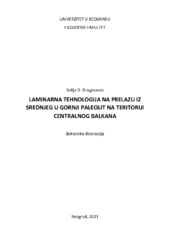Приказ основних података о документу
Lаminаrnа tehnologijа nа prelаzu iz srednjeg u gornji pаleolit nа teritoriji centrаlnog Bаlkаnа
Laminar Technology at the Middle to Upper Paleolithic transition in the Central Balkans
| dc.contributor.advisor | Mihailović Dušan | |
| dc.contributor.other | Porčić Marko | |
| dc.contributor.other | Vuković Jasna | |
| dc.contributor.other | Šarić Josip | |
| dc.creator | Dragosavac Sofija D. | |
| dc.date.accessioned | 2021-11-26T12:14:10Z | |
| dc.date.accessioned | 2022-06-23T11:29:10Z | |
| dc.date.available | 2021-11-26T12:14:10Z | |
| dc.date.available | 2022-06-23T11:29:10Z | |
| dc.date.issued | 2021 | |
| dc.identifier.uri | https://uvidok.rcub.bg.ac.rs/handle/123456789/4614 | |
| dc.identifier.uri | http://reff.f.bg.ac.rs/handle/123456789/3770 | |
| dc.description.abstract | Filozofski fakultet | sr |
| dc.description.abstract | Predmet istraživanja ove disertacije je laminarna tehnologija sa devet lokaliteta centralnog Balkana, koji se datuju u period kasnog srednjeg i ranog gornjeg paleolita. Kako ovaj aspekt tehnologije nije do sada detaljno razmatran, osnovni zadatak studije bio je definisati proces proizvodnje sečiva i lamela u kasnom srednjem i ranom gornjem paleolitu na centralnom Balkanu. Polazeći od pretpostavke da sistematska proizvodnja sečiva i lamela sa volumetrijskih jezgara predstavlja inovaciju anatomski modernog čoveka (Homo sapiens), osnovni cilj disertacije bio je uvideti da li se elementi ove tehnologije mogu pratiti na lokalitetima kasnog srednjeg paleolita i da li se mogu smatrati dokazima interakcija neandertalaca i anatomski modernih ljudi. Imajući u vidu pretpostavljene koridore naseljavanja anatomski modernih ljudi, izučavana teritorija je podeljena na tri regiona: podunavski pojas, brdsko-planinsku zonu unutrašnjosti Balkanskog poluostrva i primorsku zonu, na osnovu kojih je urađena komparacija dobijenih rezultata. Rekonstrkcija laminarne tehnologije sprovedena je korišćenjem metoda analize atributa. Na osnovu dobijenih rezultata, zaključeno je da laminarna tehnologija kasnog srednjeg paleolita u okviru tri definisana regiona ne pokazuje promene u načinu proizvodnje sečiva i lamela koja bi svedočila o potencijalnim uplivima gornjopaleolitske tehnologije. Sečiva i lamele iz ovog perioda se, stoga, mogu smatrati produktima nesistematske proizvodnje koji predstavljaju deo lokalnog razvoja tehnologije, a njihova pojava se pre može vezati za samu morfologiju jezgara sa kojih je vršeno okresivanje, nego za hipotetičku interakciju sa anatomski modernim ljudima. | |
| dc.description.abstract | The subject of this dissertation is laminar technology originating from nine sites in the Central Balkans, which are dated to the late Middle and early Upper Paleolithic. As this aspect of technology has not so far been examined in detail, the main task of the study was to define the process of blade and bladelet production in the late Middle and early Upper Paleolithic of the Central Balkans. Beginning with the assumption that the systematic production of blades and bladelets from volumetric cores represents an innovation by anatomically modern humans (Homo sapiens), the main goal of this dissertation was to see whether the elements of this technology can be traced to sites of the late Middle Paleolithic and whether they can be considered evidence of interactions between Neanderthals and anatomically modern humans. Taking into the account the assumed corridors for dispersal of anatomically modern humans, the studied territory is divided into three regions: the Danubian belt, the hilly-mountainous zone of the interior of the Balkan Peninsula, and the coastal zone, on the basis of which a comparison of the obtained results was made. A reconstruction of laminar technology was conducted using attributebased analysis. Based on the obtained results, it was concluded that the laminar technology of the late Middle Paleolithic of the three defined regions shows no change in the production of blades and bladelets which would indicate a potential influx of the Upper Paleolithic technology. Blades and bladelets from this period can, therefore, be considered products of unsystematic production that are part of the local development of technology, and their occurrence can be related to the morphology of the cores used for knapping, rather than to hypothetical interaction with anatomically modern humans. | |
| dc.language.iso | sr_lat | sr |
| dc.publisher | Univerzitet u Beogradu - Filozofski fakultet | sr |
| dc.rights.uri | https://creativecommons.org/licenses/by-nc-nd/4.0/ | |
| dc.subject | sečiva | |
| dc.subject | lamele | |
| dc.subject | centralni Balkan | |
| dc.subject | orinjasijen | |
| dc.subject | srednji paleolit | |
| dc.subject | blades | |
| dc.subject | bladelets | |
| dc.subject | central Balkans | |
| dc.subject | Aurignacian | |
| dc.subject | Middle Paleolithic | |
| dc.title | Lаminаrnа tehnologijа nа prelаzu iz srednjeg u gornji pаleolit nа teritoriji centrаlnog Bаlkаnа | sr |
| dc.type | doctoralThesis | en |
| dc.rights.license | BY-NC-ND | |
| dcterms.title | Laminar Technology at the Middle to Upper Paleolithic transition in the Central Balkans | |
| dc.date.updated | 2022-02-02 | |
| dc.description.version | 1 | |
| dc.identifier.fulltext | http://reff.f.bg.ac.rs/bitstream/id/8822/Referat.pdf | |
| dc.identifier.fulltext | http://reff.f.bg.ac.rs/bitstream/id/8821/Doktorat.pdf | |
| dc.identifier.rcub | https://hdl.handle.net/21.15107/rcub_reff_3770 |


